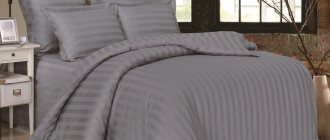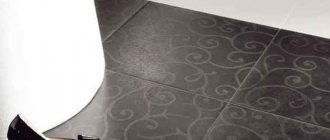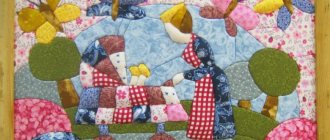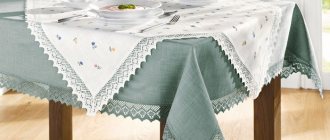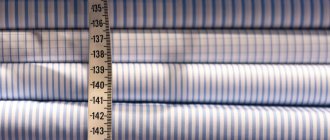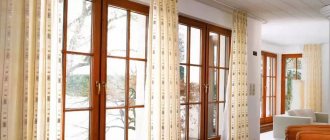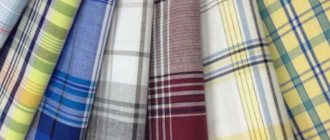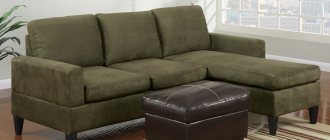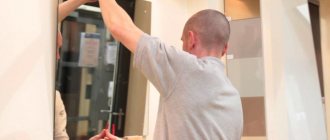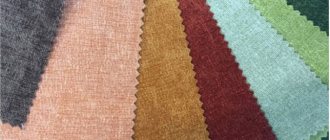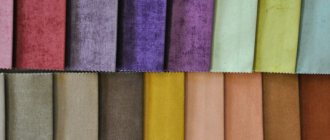Percale is a surprisingly durable fabric. At one time, it was used to make skins for the first aircraft, sails and parachutes, and now products made from it are classified as “premium”.
Initially, this fabric was a 100% cotton fabric made from long-pile threads. Later, silk, polyester and polyester were added to weaving.
The density of modern percale is 100-160 threads per 1 square centimeter .
Sometimes the main material is not cotton, but linen. Variability does not affect the quality in any way. It will not be possible to distinguish one type from another either visually or by touch.
Both are created exclusively from untwisted threads of the same length, hence their smoothness and resistance to wear.
The villi are connected to each other using a special solution. It doesn't wash out. The fabric made from it does not delaminate after washing, but becomes softer. Not afraid of high temperatures.
Definition and general description
Percale is a dense plain weave fabric, smooth, without shine, and washes well. Often used as bedspreads. The density of this material is about 200 (or even more) threads per square meter. cm, which is much more than the fabric used to make bed linen. Percale is such a durable fabric that it was once used to make sails, parachutes, and even the skin of early airplanes.
Percale colors
At first, the fabric was made from pure cotton of long-pile varieties,
later silk and synthetics began to be added to the weaving. Sometimes flax is used as the main material, which does not in any way affect the properties (smoothness and wear resistance) of percale, the main production principle of which is the use of only untwisted threads of the same length.
Modern percale can have a lower density (from 100 threads per sq. cm), it is produced from both carded and combed yarn and can be woven from different fibers, including blended and synthetic. The villi are connected to each other using a special solution that does not separate and is not washed out during washing.
It is believed that the best percale is produced in India, Pakistan, Indonesia, Egypt and Turkey. The largest European producers are France, Italy and Portugal. In Russia, this fabric is produced mainly at enterprises in the Central region - in the Ivanovo, Moscow, Vladimir and Leningrad regions. The largest of them is Teykovsky Cotton Mill (Ivanovo region)
How to spot a fake
Due to the great interest shown in percale fabric, it began to be counterfeited very often. To protect yourself from counterfeiting, you should purchase material only at large points of sale, having first examined the surface of the fabric and the label indicating its composition. You should not look for a cheaper product, since this type of material is considered expensive and savings can be achieved by replacing components.
When purchasing, be sure to ask for quality certificates that natural fabrics must have. If the packaging is tight, ask to unwrap it and take a closer look at the purchased product. Natural fabric is made from untwisted threads and has no gaps due to its high density.
Origin story
The name of the fabric most likely comes from the Persian word pargala, which means "rag". Percale came to Europe in the 17th century from India. The first Europeans to master its production were the French, who in 1770 tried to make ship sails from linen soaked in linseed oil.
However, oil was expensive, so percale sails appeared on French ships only in 1806. And in 1814, the Queen of Great Britain’s fleet began to be equipped with such sails.
Oil
How did oil fabric appear and what are its main properties?
more details
Domestic sleeping sets
Double set of percale “Camellia” from the manufacturer Tex-Design
The largest producers of these products are the cities of Ivanovo and Chernigov. Both centers for creating percale fabric in Russia specialize in fabrics without synthetic fibers.
Russian percale pleases with a large number of colors and high quality. And also relatively low prices. After reading the reviews of this material, you will see for yourself.
Fabric composition and properties
Percale, made entirely from natural materials (cotton or linen), tends to wrinkle, which is explained by the special density of the threads.
To avoid this, in our time artificial threads, usually made from special polyester, are often added to natural fibers.
Percale has no equal in its wear resistance - the fabric can withstand up to 1000 washing cycles. Thanks to the weaving method, there are no pills, folds or stretches on the fabric - percale remains smooth and soft even after long use.
The threads are fastened together with a very adhesive solution, so the fabric practically does not shrink (maximum 2%) and does not form lint on the surface. This technological process is called sizing, and a mixture of glycerin, animal fats and potato starch is used as a solution (sizing).
Percale:
Hygienic
Not electrified
Does not cause allergies, so bedding made from this material is suitable for children and people with respiratory tract and skin diseases
Light and gentle
Non-flowing and pliable
All these properties make the fabric ideal for sewing items with decorative elements such as lace inserts.
Care instructions
First wash
- optimal temperature: 45 degrees.
- do not use bleach.
- don't boil.
- do not soak.
- Before washing, let the laundry rest in a cool room.
- don't starch.
- do not use hard water.
Subsequent washes
- optimal temperature: 80 degrees.
- Use only mild detergents.
Drying and ironing
- squeeze thoroughly.
- Do not leave clean laundry in the washing machine for a long time.
- Both horizontal and vertical hanging methods are suitable.
- When hanging, keep in mind that wet fabric wrinkles a lot.
- You can hang it on both the reverse and reverse sides, as percale does not fade in the sun.
- optimal temperature for ironing: 140-150 degrees.
Advantages and disadvantages
Advantages of percale:
- Strength and durability - the service life of percale bed linen reaches 10-15 years.
- Softness.
- Resistant to deformation, sun fading, shedding and pilling.
- Hygroscopicity.
- Breathability.
- Impermeability – does not let feathers and fluff out, maintaining the integrity of the stuffing.
- Hypoallergenic.
- Moderate dirt-repellent effect.
- Aesthetic appearance.
Disadvantages of fabric:
- Possibility of shrinkage (albeit very small - within 2%).
- Possibility of allergic reactions to the components of the dressing (animal fats, glycerin, starch).
- Difficulty in care.
- High price.
Varieties of percale
Textile factories produce the following types:
- Technical. It is used to create tents, parachutes, awnings, and specialized industrial covers. Increased values of wear resistance of this type are formed through additional treatment with special solutions. They increase strength and density, and also make the structure almost water and dustproof.
- Domestic. This option is in demand for various consumer needs, therefore it is used for sewing bed linen, clothing, table textiles (tablecloths, napkins, etc.).
The material has very high strength, however, at the same time it is quite light and airy.
Varieties for household use are further divided into several types according to the method of drawing:
- bleached;
- plain painted;
- printed;
- jacquard;
- embroidered.
The fabric has high thermoregulating properties: in the summer it will not be hot to sleep under such underwear, and in the winter it will not be cold.
Norms and standards for manufacturing
The standards taken into account in the production of technical percales are described in GOST 12125-66. For the production of materials of this GOST, yarn numbers usually above 100 are used, made from the best varieties of long-staple cotton.
According to the requirements of the State Standard, fabrics with a weight per square meter from 60 to 100 g must withstand tensile loads of up to 450 N. Such strength is achieved by observing another standard - the density of the weft and warp (400-500 threads per 1 inch) in plain weave.
Percale for household use is produced in accordance with GOST 31307-2005, which contains the requirements for the consumer properties of the fabric. For example, the air permeability of the material for the manufacture of children's bedding should be at least 100 cubic decimeters per 1 sq.m, and hygroscopicity - at least 15%.
Subtleties of choice
For a comfortable sleep, you need to choose natural cotton. European manufacturers always include pieces of fabric so that each buyer can verify the peculiarities of the structure of textile products.
Percale sets must have a clear pattern, not blurred along the contour. Pastel shades and natural tones are trending. Multi-colored bright sets with funny animals or cartoon characters especially delight school-age children. This is the best linen option for winter. By the way, the color of percale on both sides is almost the same, this is explained by the good absorption of the dye.
You can often find plain products with lace inserts or frills. Embroidery looks great on thick fabric that shrinks slightly after washing. The size of the linen deserves attention; more often, manufacturers offer a Euro format; there are sheets with elastic and duvet covers with snaps.
Important! In retail there are mixed percale varieties. To reduce the cost of production, synthetics are added to cotton; the properties of such textiles are noticeably worse than those of natural ones. When purchasing, be sure to pay attention to the composition of the fabric.
Children love silky, warm percale underwear in beautiful colors.
How much does percale cost?
You can buy percale made from pure domestically produced cotton in bulk at prices ranging from 160 to 300 rubles per linear meter. Retail prices per meter are on average 20-30 rubles more expensive. A set of bed linen (double version) will cost on average from 1,500 to 2,500 rubles. Luxury sets from European manufacturers are sold at prices ranging from 7 to 40 thousand rubles.
High prices for percale products have not made this fabric less popular and in demand on the market. The long and reliable service of this material pays off the costs.
What's better?
It is recommended to select bed linen depending on personal preferences and technical properties. High-density fabrics made using calico or poplin weaving are suitable for the beds of small children. In other cases, it is better to choose a cotton fabric option that is suitable for softness and design.
Despite the presence of synthetic fibers, percale does not contain static electricity.
Silk
Silk is a soft fabric, its threads are obtained from the cocoons of the silkworm. The triangular cross-section of silk threads beautifully reflects light, giving the products an expensive, sophisticated look. Silk is used to make not only bed linen, but also clothing and interior elements.
Advantages of silk fabric:
- exceptional durability;
- pleasant to the touch, very light;
- hypoallergenic;
- very beautiful.
Caring for silk fabrics is not easy, but silk products are bought all over the world. The inconvenience in maintenance is not so great, but a person gets great pleasure using this noble material.
Jacquard
Jacquard is a lint-free, smooth fabric with complex weaving. It is made from cotton yarn, although there are also synthetic fabrics. Jacquard of organic origin is used for bed linen, and as the thickness of the threads increases, the strength of the fabric increases. Jacquard is considered a noble and expensive fabric; luxury bed linen is made from it. This material is also used to cover mattresses and furniture, and to make clothes from it.
Advantages of jacquard fabrics:
- special density allows you to absorb excess moisture;
- the material dampens electrostatic fields;
- jacquard weave provides a beautiful surface;
- the fabric regulates body temperature and resists high temperatures well;
- the properties of the fabric are preserved for a long time.
